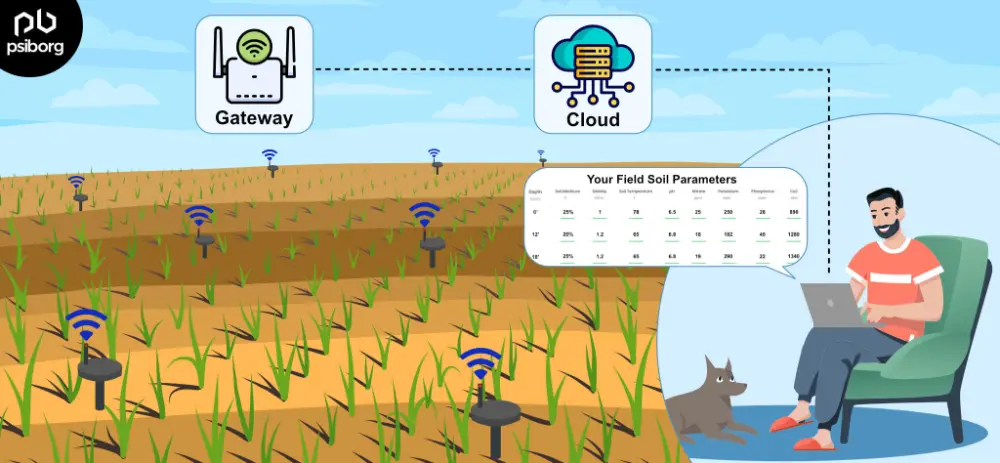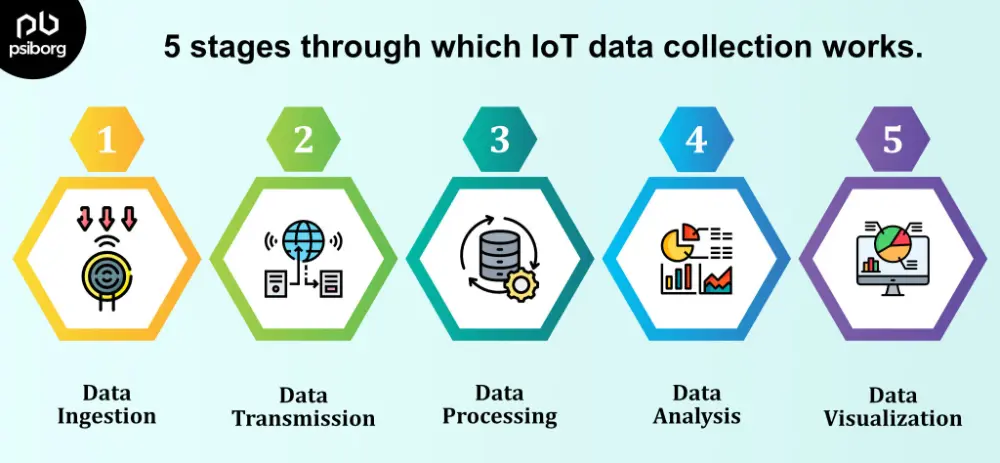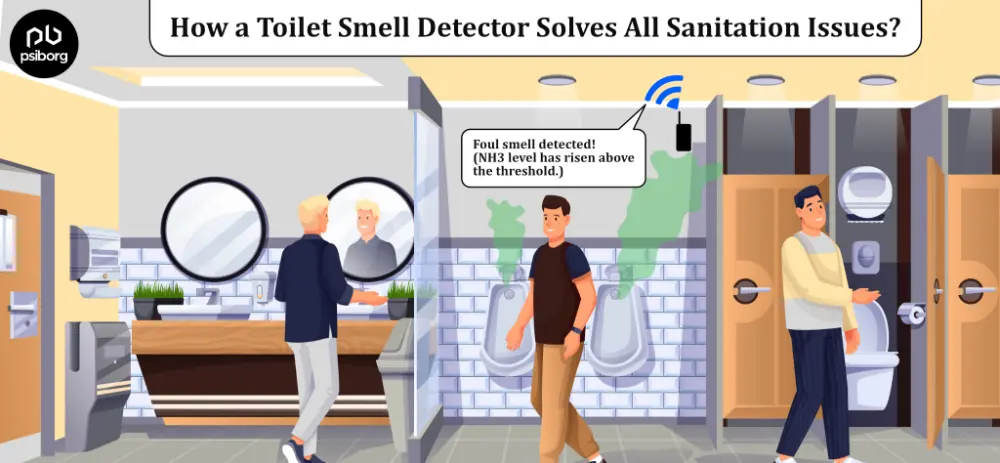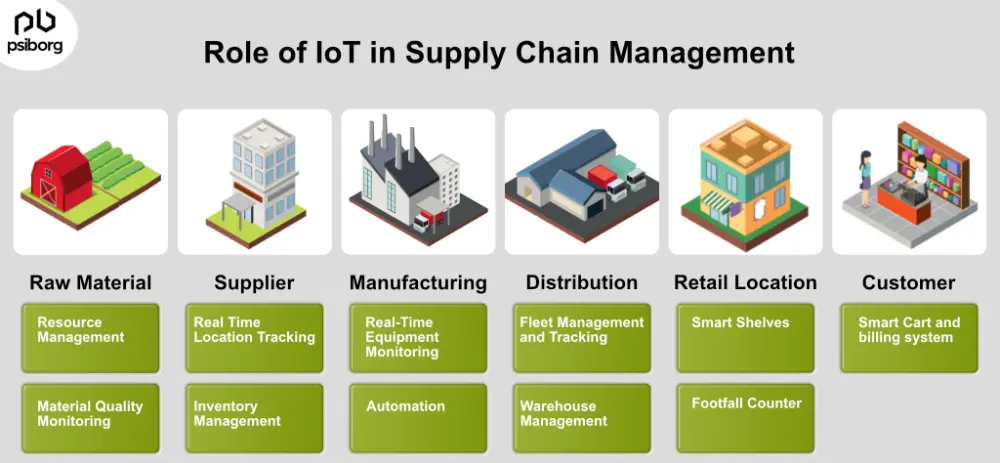Everything is based on data. Basically, if you get data on how much electricity you are consuming per day, you can use that data to reduce your monthly electricity bills.
This is what IoT technology offers -“IoT data collection.”
IoT systems provide data to improve every process.
That’s why we say, IoT can be integrated anywhere and everywhere.
Moreover, I’m sure you know the importance of data-driven decision-making. The Internet of Things system allows you to make data-driven decisions.
The IoT has actually revolutionized data collection methods across all industries.
To give you an overview, the smart IoT devices and sensors installed in a specific area collect data from the surrounding environment and transmit it further to the cloud, from where the data is sent to our dashboards, where we visualize it.
But, how did this all begin, and how did the data collection work?
Well, let’s get an answer to this question through this blog.
Being an IoT service provider company, PsiBorg is experienced in IoT-based data collection. Read till the end to get some valuable insights about the topic.
Let’s start by defining IoT data collection first,
IoT Data Collection
Here, the term IoT data collection can be defined as the process of using sensors to track and collect data on the surrounding environment in real time. Furthermore, these data can be collected, transmitted, stored, and retrieved at any time.
However, IoT data can be of different types.
Types of IoT Data
The IoT data is majorly of three types, based on the IoT devices that are generating it and the use cases of the devices.
1. Status data
It can be defined as raw data that communicates the real-time status of the devices or the environment to be monitored.
2. Automation Data
This foregoing type of data is created by automation devices and systems like automated irrigation systems or automated lighting systems.
3. Location Data
The aforementioned type of data is the IoT data that communicates the geographical location of the system. The most common examples where location data is required are – logistics, warehouses, and manufacturing.
Explain Like I’m 5 years old!
Consider a farmer who has a super cool system that can spy on and look at the entire farm while the farmer is away. Now, this supercool system includes small gadgets with special powers. Some gadgets can feel how wet the soil is, some can see how much sunlight the plants are getting, and some can also detect the creepy crawlies that munch on leaves and harm them.
Nonetheless, these smart gadgets are called IoT sensors. However, these sensors have to pass on the message, and for this, they use a special translator. Here, the translator is another part of the supercool system and is called the gateway. The gateway receives all the messages from the sensors and sends them ahead in the journey.
Finally, the message travels through an invisible highway (internet) and reaches the big brain, i.e., the cloud server.
Eventually, this super cool system and gadgets are what the grown-ups call the “Internet of Things,” or IoT.

Meanwhile, a farmer who has installed a network of IoT devices and sensors in his field can monitor soil moisture remotely and in real time using sensors distributed throughout the field.
How IoT Data Collection Work?
IoT data collection involves the teamwork of several layers to provide the data in human hands.
There are 5 stages through which IoT data collection works.

Here, the journey of data collection ends when the data is sent to the cloud for analysis.
We have already mentioned what is IoT and how IoT technology works in our previous blogs.
So, let’s just skip this part and understand how the data gets its way to the cloud.
1. Data Ingestion
Sensors are the main foundation, or backbone, of IoT data collection. These tiny smart devices are deployed in the field, from where the data is to be collected and measured. For instance, in a smart agriculture system, the sensors collect data about the surrounding environment, like temperature, humidity, soil moisture, or light intensity.
To be precise, soil moisture-related data is transmitted to the cloud, where a powerful algorithm processes and analyzes the data. When the soil moisture level falls below the threshold value, the IoT system can trigger irrigation systems to deliver the set amount of water needed.
Hence, the data-driven automated irrigation system approach will make sure that the water is not wasted and will also promote healthier crop growth and effective farming practices.
2. Data Transmission
These tiny smart devices can’t keep all the information to themselves, it needs to be transmitted further. For this, sensors use a special translator, which is called a gateway.
The IoT gateway receives all the messages and information from the sensors and sends them forward to the further journey.
For effective communication and data transmission, the gateway can use both cellular and satellite communication.
(In an IoT system, each event and step creates data. This data should be transmitted securely. For this, protocols such as SigFox, LoRa, MQTT, CoAP, ZigBee, etc. are used.)
3. Data Processing
The gateway sends the data to the cloud server. The cloud server acts as the brain for the whole process. On the cloud, all the collected data is processed, like how much soil moisture is depending on the plant type.
4. Data Analysis
To make use of all the collected data, data analysis is done by utilizing all the historical data. This helps in getting some actionable insights. Insights are done to predict any future events that may occur.
For instance, by analyzing all the data, we can schedule the irrigation time and predict possible future malfunctions.
5. Data Visualization
This is the fun part. With all the stored, processed, and analyzed information, smart decisions are made.
The processed data is sent to the end user by providing alerts in the form of alerts, emails, and notifications. The IoT system also comes with a dashboard that allows the user to proactively check the ongoing process.
(Businesses can make important business decisions based on the insights and predictions generated through IoT data collection.)
Furthermore, it’s also important to decide how the data should be accumulated and stored for further use. For this, you must decide whether the data should be sent in real-time or in batches.
Also, you have to choose in what order the data points should be created for accurate analysis.
Why is Data Collection Important?
Businesses and organizations use IoT data in various ways to achieve their business goals. Some of the benefits that IoT data brings to the table and increased interest of businesses in IoT are:
1. Improves Operational Productivity
By getting data from the connected system, one can identify the hitches in the operation and identify opportunities to increase productivity.
2. Helps in Gaining Awareness
Getting aware of the surrounding environment, like the equipment’s working status and their health, helps schedule their maintenance ahead of time. This will prevent the occurrence of issues and help in getting over the obstacles swiftly, even if they arise.
3. Generates New Revenue Streams
IoT data collection is very beneficial for marketing purposes. The data collected by IoT devices can help in understanding how customers are using the products/services.
With this information, businesses can spot opportunities for improvement and increase revenue.
4. Makes Marketing More Effective
When you get information about why end-users are buying your product and in what region or age group are using it, you can target your marketing accordingly to get maximum leads.
5. Improves Security
With IoT devices, it gets way much easier to improve the safety of buildings, assets, and equipment. Plus, you will get a record of when the assets are used and at what time, without any physical interference. This is very helpful in maintaining internal security and addressing security breaches, in case they happen.
How will IoT-Enabled Data Collection Benefit Various Industries?
The above-mentioned benefits of IoT data collection are applicable in each and every sector, but just for the sake of not omitting any point, let’s get through the benefits of IoT data collection across all industries.
1. Healthcare
The personal healthcare and medical industry uses IoT systems and devices to monitor and track everything, be it the patient’s health or the medical equipment. In the healthcare industry, IoT data collection can be utilized to track patients in real time, find assets quickly when needed, and manage the entire hospital infrastructure.
2. Manufacturing
Production and manufacturing businesses make use of IoT data collection to monitor production line operations and detect any potential issues for proactive maintenance. Manufacturing industries can increase uptime and reduce operational costs by leveraging IoT data.
3. Retail and Ecommerce
Ecommerce brands and retail companies use the data collected by an IoT system to effortlessly monitor and manage their inventory. Retail and Ecommerce businesses also use IoT to improve their supply chains and track orders in real-time.
4. Media and Entertainment
The media industry can use IoT data collected by IoT sensors to run personalized marketing campaigns for their target users. IoT data also supports the media industry by tracking the consumer’s response to the products and the improvement in business after marketing campaigns.
5. Agriculture
We have already mentioned the use cases of IoT data collection in the agriculture industry throughout this blog. Still, to state some, IoT data collection aids agribusinesses in tracking farm animal health, soil health monitoring, pest monitoring, and asset management.
6. Public sector
Data collected by IoT sensors is used in smart buildings and smart cities for traffic management, parking management, street light automation, and other applications. Currently, IoT data collection is the most effective method for smart city planning.
Also read: Smart Parking System Using IoT
Choose PsiBorg for IoT Data Collection
To increase business revenue, organizations must start utilizing IoT data. Some businesses have foreseen the IoT potential and are working on it, while others are still sticking to traditional methods.
If you are the one who understands the IoT potential, then PsiBorg can help you achieve your goals. PsiBorg is an IoT development service-providing company that offers end-to-end IoT solutions to businesses.
In addition, one good reason to trust PsiBorg is our expertise in developing IoT solutions for businesses across all the above-mentioned industries.
We have assisted businesses with IoT device development, IoT data collection for crop yield improvement, real-time monitoring of cattle health, shipment tracking, inventory management, predictive maintenance, and much more.
Thus, if you need a partner who can help you with IoT data collection and IoT device development, then PsiBorg Technologies is the right name that you should look for.
Why wait? Contact us today with your specific requirements, and our team will walk you through the entire process of collecting and storing IoT data.
FAQs
An IoT device collects data through the sensors embedded within it. These sensors sense and collect the needed data from the surrounding environment. This collected data is then transmitted wirelessly to a centralized system for insight and analysis.
IoT data collection begins with sensors that collect data. These sensors capture environmental or operational data, such as temperature, motion, or pressure, initiating the data ingestion process.
The storage of IoT data is completely dependent on the use case. Because IoT devices can store data locally on their onboard memory or remotely on cloud-based servers.
However, each use case has its own unique requirements and they might allow for delays. For instance, in applications like security, which is a time-critical event, there’s no room for even minor delays. That’s why local storage is done to get quick access to data.






